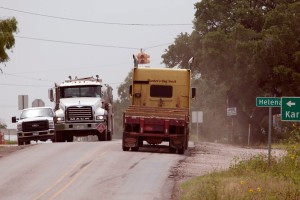As Drilling Operations Continue, Texas Roads Suffer

Truck traffic on FM 81 in the Eagle Ford Shale formation area. Photo courtesy Texas Department of Transportation.
According to the Texas Department of Transportation it takes nearly1,200 trucks to bring a gas well into production. TxDOT says those trucks do damage to roads equal to nearly 8 million cars.
That’s a lot of wear and tear.
So it makes sense that the state of Texas roads would get some attention during the Texas House Committee on Energy Resources’ two-day marathon of hearings on the impact of state’s energy industry this week.
Phil Wilson, TxDOT’s Executive Director, and John Barton, the deputy director and chief engineer, went before the committee to discuss the problem.
They said improving roads will serve two purposes. It will help the communities impacted by heavy trucking, and it will help industry.
Barton says the problem is “particularly acute on highways, roads and bridges not designed or constructed to accommodate heavy loads.”
“The sudden explosion of drilling activity [is] requiring local governments to ramp up maintenance and repair efforts,” said Barton. But counties do not have the money to fix the roads.
Rebuilding a paved road can cost more than $1 million a mile — that’s the entire budget for many counties’ road and bridge departments, says Barton. “That would be enough money to rebuild a mile or two, but only if the county stopped all other spending for brush control and other routine maintenance.”Heavy trucking on rural roads has created a problem for law enforcement as well. Many rural roads were built when the standard size for construction was 18 feet across, nine feet for each lane — it’s now 24. That doesn’t allow state troopers enough room to stop trucks. There’s no area to pull them over on many of these roads, causing a safety hazard.
Barton recommended keeping a careful eye on maintenance. “You have to make the conscious decision to do it today with the resources that we’ve got,” says Barton. A stretch of road with ten or more wells in the area would cost $5 million to maintain, but the same stretch would cost $27 million to rebuild once damaged.
Still, even the price tag for simple maintenance will be steep for the perennially cash-strapped TxDOT. The Department recently allocated $40 million to repair roads hit hard by drilling operations in the Barnett and Eagle Ford Shales, according to Bloomberg News. At $5 million dollars a road for upkeep, that pot of money could be quickly ground into dust.
TxDOT is also seeking public comment. It’s taken that mission, ironically, on the road.
“We’ve already held two meetings to gather data to quantify the impact of energy-related activity on state roads and bridges,” Wilson told the committee. The next meeting will be in Cleburne, Texas. No word whether TxDOT officials expect a bumpy ride there.


